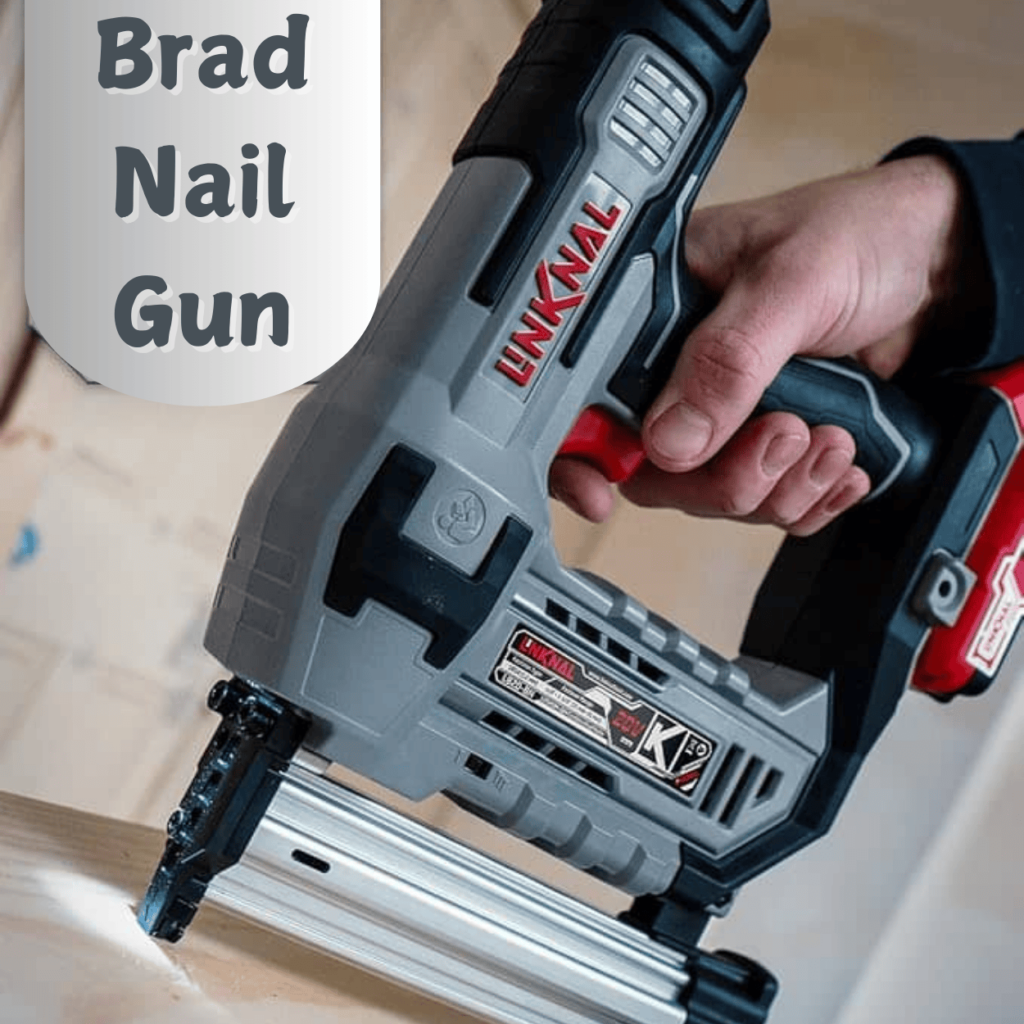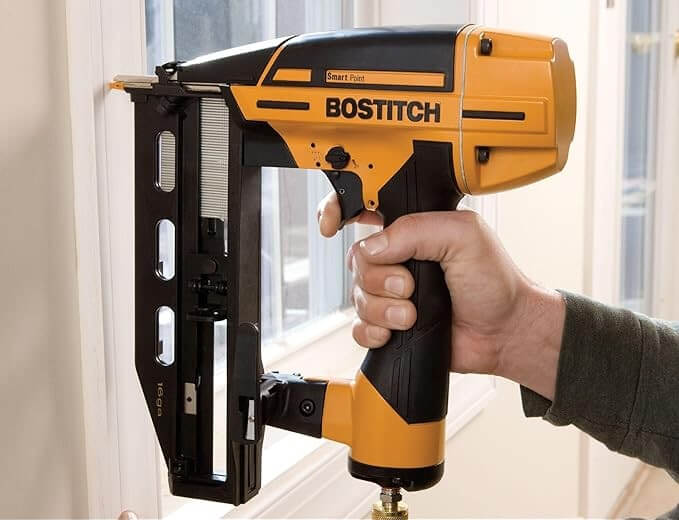A brad nail gun uses 18 gauge thin nails, also called “Brads“. They are thin enough for lightweight or delicate woodwork. they do not require much holding power.
In contrast, finish nailers use 15 or 16-gauge nails, thicker than brads. These nails offer greater strength and enough holding capacity. This tool is suitable for heavy-duty trimming, baseboards, and large projects.
In this article, we will discuss brad vs finish nail gun. Here, you will learn the differences between these two toolsl in detail. We will also highlight them individually.
What’s a Brad Nail Gun?

A brad nailer is a type of nail gun that uses 18 gauge nails (Between 5/8″ to 2″). Brad nailers are designed for lighter-duty applications than finish nailers and are often used for trim work, picture framing, and other tasks where a smaller, less visible nail is needed.
There are two types of versions available in the market. One is a brad air nail gun, and the second one is a brad nail gun battery. A brad air nail gun requires an air compressor to supply air while nailing. Moreover, a brad nail gun battery requires a lithium-ion rechargeable battery to function.
Brad nailers have several key features over finish nailers. The main feature of this nail gun is less surface damage. Due to smaller nail sizes, they create almost invisible holes than other nail guns.
Moreover, this feature also makes this tool suitable for delicate wood materials, because it has no wood splitting chances. In contrast, they provide minimum holding power, since brads are thin.
These nailers are also very versatile and can be used for a variety of tasks. They are ideal for trim work and picture framing.
Brad nailers can also be used for small trims or molding, especially on cabinets and furniture, installing small pieces of trim, and crafting hobby projects.
Brad Nailer Pros & Cons
Pros
Great for Light-Duty Tasks
The 18-gauge brad nails are perfect for lighter-duty tasks such as picture hanging, molding, and trim work. The more delicate the material, the better a brad nailer will handle it.
Easy to Use
Another advantage of using a brad nailer is that they’re relatively small and easy to maneuver. This makes them ideal for working in tight spaces or for projects that require a lot of detailed work. These nailers are lightweight as well. So, you won’t get tired of using them for extended periods.
Less Likely to Split The Wood
Brad nailers are less likely to split the wood. This is especially important when working with delicate moldings or trim. So you don’t have to worry about leaving unsightly marks on your workpiece.
Cheaper Than a Finish Nailer
In terms of brad nailer vs finish nailer, brad nailer is cheaper than finish nailer. Because they’re not built for heavy-duty use and don’t require the same amount of power as finish nailers. If you’re looking for an affordable option, a brad nailer is a good choice.
Cons
Less Powerful
One of the worst things about a brad nailer is that it isn’t as powerful as a finish nailer. If you need to do any heavy-duty work brad nailer is not a better option. If you have thicker materials, then a brad nailer won’t be able to complete the job effectively.
Not Enough Holding Power
Another downside to brad nailers is that they don’t have enough holding power. Because they use smaller nails. As a result, they’re not as good at holding together heavier materials or pieces of wood and other materials if required.
Not Ideal for Materials Other Than Wood
Materials such as MDF, particleboard, and even some hardwoods can be difficult to work with using a brad nailer. This is because the smaller nails tend to split these materials more easily. If you need to work with any of these materials, then you’re better off using a different type of nailer or another tool altogether.
Brad Nail Gun Uses
Trimming
Trimming requires accuracy and a light touch—two qualities that a brad nailer has in spades. If you’re working with molding or any other type of trim, a brad nailer will help you get the job done quickly and neatly.
Decorative Molding
When working with decorative molding, you need a nailer that doesn’t leave any spots! And that’s exactly what a Brad nailer will do. It’s the perfect tool to use when you want to add a little something extra to your home decor.
Paneling
Paneling is a great way to add some visual interest to your walls—and a brad nailer is a perfect tool to help you do it. With its small, precise head, a brad nailer will help you to complete the job quickly and easily.
Attaching Casings to Furniture
Pieces of Furniture are often made with delicate materials that require a light touch. A brad nailer is perfect for this job, as it won’t damage the material and will provide enough holding power to keep the piece together.
Small Woodworking Works
Small woodwork such as building jewelry boxes, bookcases, and picture frames are ideal for a brad nailer. Not only it is the perfect tool for the job, but it’s also small enough to maneuver easily in tight spaces.
What is a Finish Nailer?

A finish nailer is designed for doing heavier trim and molding. It uses comparatively thicker nails like 15 or 16 gauge nail. Unlike brad nailers, finish nailers use bigger nails.
The most common size for finish nails is 15-gauge, but you can also find them in 16 gauge size. The smaller the number, the bigger the nail.
The key feature of this nail gun is it applies deeper penetration and strong holding power. Another feature of finish nailers is they can be used for a wider range of projects, larger construction works, and hardwood flooring.
The main benefit of using a finish nailer is the ability to provide a professional and aesthetic finish on larger projects.
These nails are also less likely to bend, making them ideal for use on harder woods. This is why this tool is valuable.
Finish Nailer Pros & Cons
Pros
Great for Working With Thick Materials
Whether it’s a hardwood or MDF, a finish nailer can handle it all. These nailers produce more holding power than a brad nailer, which is ideal for working with tough materials. It also produces more air pressure, so it can handle tougher materials without stalling.
Customization the Depth
One of the biggest advantages of a finish nailer is that you can customize the depth. This means that you can control how far the nails go into the wood. This makes the nailer very useful for different applications.
Can Handle Different Materials
Plywoods and MDFs can be hard to work with, but a finish nailer can make the task easier. 15 or 16-gauge finish nails are ideal for these materials. Bigger nails are better for nailing into hardwoods. So these nailers are ideal for a variety of tasks.
Cons
Possibility of Jamming
In the case of finish nailers, there is a possibility of jamming. The use of the wrong types of nails and improper loading are the main reasons behind it. Clearing jams is very time-consuming and annoying.
Cost
A finish nailer can be very expensive. Occasional DIYers who may not use it frequently enough need to justify the investment.
Need of Maintenance
Finish nailers always require maintenance regularly. It also needs proper oiling and cleaning, otherwise it will lead to performance issues because of negligence.
Air Compressor
If you want to practice a pneumatic finish nailer for additional power, you will be required to invest in an air compressor.
High Chance of Split
Finish nailers are not appropriate for use on slim and delicate materials. Since the nails are wide and long, there is a high chance they will split any thin materials—no space for extra power.
What is Finish Nailer Used For?
Installing Cabinets or Crown Molding
The best use of a finish nailer is installing cabinets or crown molding. You’ll be working with long and heavy pieces of wood, which are difficult to install with a regular hammer. A finish nailer will make your work a lot easier and faster.
Window and Door Casing
Windows and doors have heavier and thicker trim, so you’ll need a finish nailer to install them. Since these nailers have more power, they can easily penetrate the thick trim.
Crown Molding
Crown molding is a type of molding that goes around the top of a room. It makes your room look nicer. Most crown molding materials are too thick and heavy to be installed with a regular hammer, so you’ll need a finish nailer.
Cabinetry Projects
Whether you’re building a new set of cabinets or just installing some cabinet doors, you’ll need a finish nailer. These nailers have more power, so they can easily penetrate thick wood.
Hardwood Flooring
If you’re installing hardwood floors, you’ll need a finish nailer to install the tongue-and-groove boards. These nailers have more power, so they can easily penetrate thick wood.
Staircase & Railings
Finish nailers are applicable for building perfect staircase components and railings. It is reliable to hold without the need for large or visible screws.
Key Facts – Brad vs Finish Nail Gun
Pricing
Now pricing can be a tricky factor to consider because both brad and finish nailer are best at their specific tasks, and the price ranges for both of them are quite different.
However, brad nailers are at least 20% cheaper than finish nailers. Basic pneumatic models of brad nailers’ price range are $30 to $80 whereas air finish nailers’ price range is between $60-$120.
Moreover, cordless models of brad nailers price between $100-$250 whereas cordless finish nailers price range between $150-$500.
From a pricing perspective, a brad nailer can be the best option for someone who is just on a budget.
Ease of Use
Brad nailers are lighter and more comfortable to use because they have smaller magazines. They are easier to maneuver around and are less likely to cause fatigue.
Finish nailers are a little bit heavier but not too much, and they have a larger magazine. They can be a little more difficult to maneuver but are still easy enough to use.
So when it comes to easy to use, Brad Nailers wins again.
Versatility
In terms of versatility, there is no denying that finish nailers are much more versatile than brad nailers.
From different materials to different thicknesses, finish nailers can handle it all. In addition, you can also adjust the depth of the nail, which gives you more control.
Brad nailers are good for smaller projects but are not as versatile as finish nailers. They are good for light-duty jobs such as molding, picture frames, and other small trim work.
Now versatility is an important part of the woodwork, so finish nailers have the upper hand here.
Delicate Woodwork
Brad nailers are the clear winner when it comes to delicate woodwork as they leave smaller holes. This is because the nails are smaller and have a narrower diameter.
Finish nailers are not as good for delicate woodwork because they leave larger holes or even cracks. This is because the nails are larger and have a wider diameter.
So if you’re doing any delicate woodwork, then you’ll want to use a brad nailer.
Working With a Hardwood
For projects like door or window frames, crown molding, and baseboards, a finish nailer is the best option.
This is because they are better at driving nails into hardwood and other tough materials. Because they generate more power and use bigger nails, they can handle tougher projects.
Brad nailers are not as good for working with hardwood because they don’t have as much power and use smaller nails. The nails will either bend or not go all the way in, which can cause problems.
So if you’re working with hardwood, then you’ll want to use a finish nailer.
Nail Removal
18 gauge stainless steel brad nails are easier to remove because of their thinness and less holding power. These nails are ideal for temporary fastening projects.
On the other hand, finish nails are harder to remove from the material as they are thicker and have strong holding power. It is almost difficult to remove without causing damage to the material. They are appropriate for permanent fastening projects.
Brad vs Finish Nailer Comparison Chart – At A Glance:
| Characteristics | Brad nailers | Finish nailers |
| Price | Brad nailers are more affordable | Finish nailers are expensive than brad nailers. |
| Easy of use | Brad nailers are easy to use | Finish nailers are not so easy to use |
| Weight | Brad nailers are on the lighter side | Finish nailers are on the heavier side |
| Versatility | Brad nailers are less versatile | Finish nailers are more versatile |
| Nail size | Uses 18-gauge nails | Uses 15-16 (or even 17) gauge nails |
| Use cases | Light trimming, Decorative molding, Paneling, Attaching pictures to the wall, etc… | Trimming, Crown molding, Working on hardwood, installing cabinetry, Chair rails, etc… |
| Damage | Less likely to damage the wood | More chances of damaging the material |
Which One is Better? Brad vs Finish Nail Gun
There is no short answer when it comes to picking a finishing or brad nailer. It all depends on your project.
Brad nailers are good for small projects, and delicate woodwork, and are easier to maneuver. They are also cheaper than finish nailers. But they are not as powerful and don’t have as much versatility.
Finish nailers on the other hand are better for big projects, working with hardwood, and are more versatile. They are a little more expensive but are worth the investment if you do a lot of woodworking.
So it all comes down to what project you’re working on and what your needs are. Either way, both brad nailers and finish nailers are great tools to have in your workshop.
Which One Can I Buy? Brad vs Finish Nail Gun
Again, it all comes down to the project you’re working on and what your needs are. If you’re just starting or working on a budget, then a brad nailer is a good option.
But if you do a lot of woodworking or need more power and versatility, then a finish nailer is the way to go.
You might want to use a Brad nailer if you are working with…
- Light trimming
- Doing delicate woodwork
- Paneling
- Furniture upholstery
- Any work that requires a smaller nail
You might want to use a finish nailer if you are working with…
- Working with hardwood
- Attaching large moldings
- Cabinetmaking
- Furniture construction
- Work that requires a larger, more powerful nail
FAQs on Brad vs Finish Nail Gun
Can I Use Brad Nails in a Finish Nailer?
Ans: No, it is not advisable to use brad nails in a finish nailer because of the different sizes of gauges. Brad nails are 18 gauge whereas finish nails are 15 or 16 gauge. If you plan to attempt this, you will face nail jamming that can damage its mechanism.
Can a Brad Nailer Use Finishing Nails?
Ans: No, an 18ga brad nail gun can not use finishing nails. 18 gauge brad nail gun’s chamber and firing mechanism are not compatible with firing finishing nails.
Are Finish Nails and Brad Nails The Same?
Ans: No, they are not the same. They use different gauge sizes. Brad nails are 18 gauge and finish nails are used to be 16 or 15 gauge. That’s why their applications are not the same.
Can a Brad Nailer Use Staples?
Ans: Most brad nailers are built to shoot thin stainless steel 18 gauge brad nails. So, they can not use staples. However, some tools, often called, crown staplers are designed to operate both brads and staples.
What is Better a Brad Nailer or Finish Nailer?
Ans: It depends on your projects. If you plan for any light-duty tasks then brad nailer is perfect. Moreover, if you plan to work on any heavier level tasks then go for finish nailer.
How much does a brad nailer cost?
Ans: The cost of a Brad nailer will vary depending on the brand, model, and features. However, you can expect to pay anywhere from $30 to $100 for a good quality brad nailer.
How much does a finish nailer cost?
Ans: The cost of a finish nailer will also vary depending on the brand, model, and features. But they are more expensive than Brad nailers, the price starts at around $70 and goes up to $200 or more.
Should I Use Brad Nails or Finish Nails for Baseboards?
Ans: Finish nailers are mainly the better choice for baseboards because this power tool applies enough strength and holding power. this power source will gently secure the baseboards to the wall. However, you can apply brad nails only in thin baseboards or if additional hold isn’t required.

